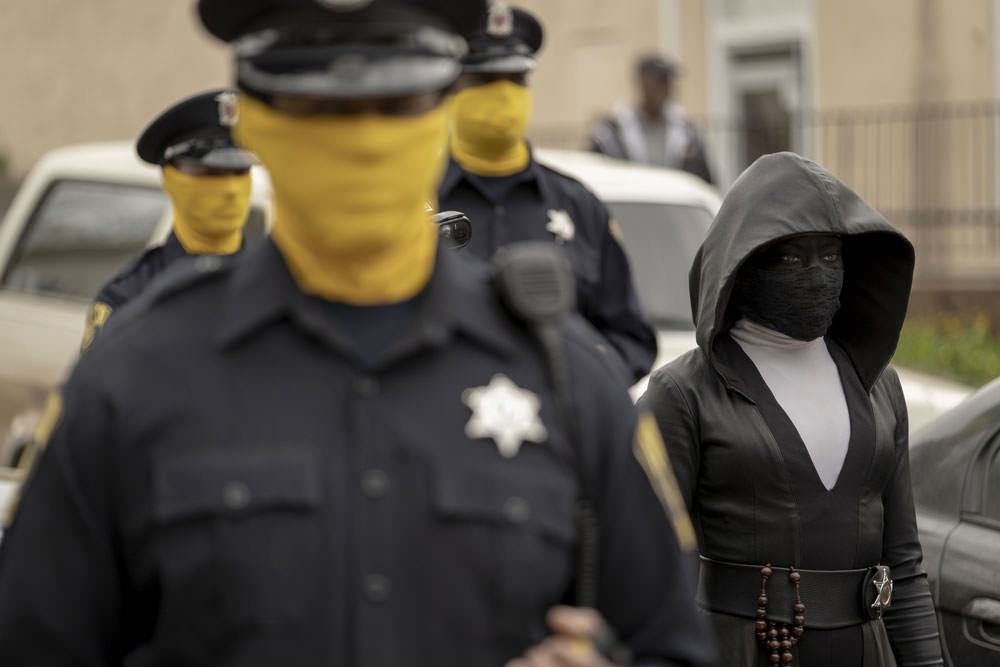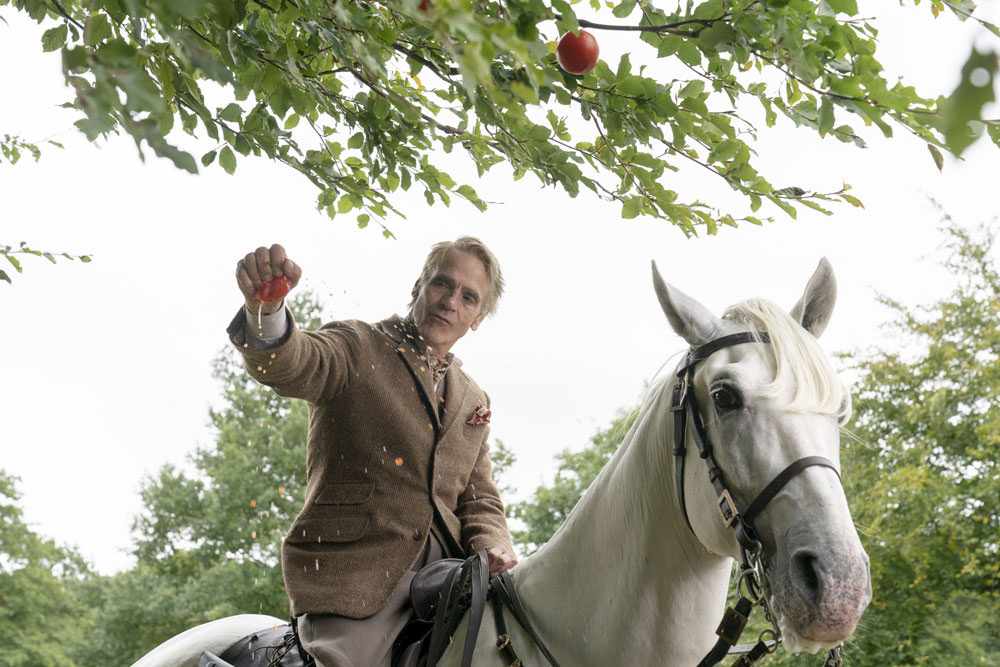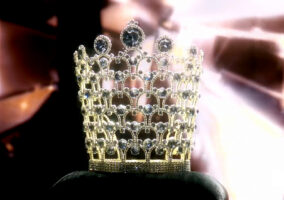
Alternate-reality dystopias tend to function as commentaries on this, our actual reality; sometimes overtly and realistically, as in the case of The Handmaid’s Tale, and sometimes in a manner that’s both much more subtle while also being far more fantastical or other-worldly in nature, as in the case of The Walking Dead. Watchmen is trying to have it both ways, which we’re starting to see more clearly in this episode. The first episode yanked the focus away from the apocalyptic and fantastical world of Watchmen‘s original material in order to make some painful examinations of America’s racist history and prove itself as a timely examination of real-world political and social issues, just as the graphic novel was back in its day. We were intrigued, to say the least. But if the premiere showed us a much more grounded version of dystopia (flying police ships notwithstanding), this second episode drastically opened things up wide in order to remind the audience that yes, this world is still goofy as hell when you get right down to it.
Yes, there’s still a lot of serious, real-world style problems facing this version of America. And Angela is carrying scars ranging from metaphorical to decidedly less so; a family history of violence (a passing reference to her parents dying in Saigon and the revelation of her connection to the Black Wall Street massacre) and the trauma of a home invasion that left her spewing blood on her kitchen floor – and also the sudden mother to her dead partner’s children. Yes, there is still a brewing race war, with cops as the main footsoldiers. Yes, the public seems suspicious, tense, and prone to conspiracy theories. All of that is painfully on display, making very clear references and comparisons to our own America in 2019, even if cell phones and the internet don’t exist.
But this is also a world where the kinds of X-Ray Specs advertised in a million mid-Century comic books are actual crime-fighting tools. This is a world where paparazzi have mechanical wings (thanks to an old WWII-era hero and member of the Minutemen named Mothman) and 100-year-old mystery men can make last-second getaways with the help of a flying car and a super-magnet. Yes, it’s a classic alternate-reality dystopia in the Man in a High Castle manner, but it’s a dystopia playing out in the literal ruins of an old superhero comic. Look at the lurid violence of the Ryan Murphy-esque American Hero Story, which switches from background to foreground depending on what it’s saying about the main story, much in the same way Alan Moore used things like pirate comics in the original material. American Hero Story turns the tale of this world’s actual first superhero Hooded Justice into an orgy of slow-motion ultra-violence and manifestos that sound like they were written by a serial killer. This may be a world where masked men and women fought evil-doers, but it doesn’t seem to be a world that loved them for it. Enter Senator Joe Keene, played by James Wolk. He’s a walking reference to the Keene Act, which outlawed masked vigilantes in the late ’70s, presumably by his father, also Senator Keene. As fascinating as it is to see this world turn towards racism as its driving theme, this episode makes clear just how firmly its rooted in the world of the original comic. Keene’s no Easter Egg, slipped in there for the fans. And you can’t exactly claim that the flying car/super magnet getaway was just some tossed-off bit of fun.
Similarly, it would seem that crazy old Adrian Veidt, who masterminded the disaster that changed history thirty years ago, is not just bumbling about a castle in semi-retirement with his collection of pretty (shoutout to Tom Mison!) but mindless servants. True, he at first appears to be unhealthily obsessed not just with the past, but with someone else’s past, mounting badly dramatized versions of the origin story of Dr. Manhattan. Incidentally, maybe we should all pay attention to how many times someone says “He’s on Mars” or “He can’t do that” every time someone brings up the possibility that Dr. Manhattan is still affecting events or, more chillingly, passing himself off as a human being. It sure does keep coming up for some reason. Anyway, the still-unnamed Adrian Veidt isn’t just putting on disturbing little clone-acted plays, he appears to have some sort of plan or scheme in mind. And given what happened the last time he had a plan or scheme (three million people dying), it would seem prudent to worry about where the hell he is (someplace where tomatoes grow on trees, evidently) and what the hell his deal is.

On the other hand, if we had to guess, we’d rate whatever Adrian’s doing as a secondary concern to whatever old man Will is doing. He insists he’s responsible for Judd’s death and that he has “skeletons in his closet.” He seemed surprised by the Klan uniform Angela found there, but we’re not sure we can trust any of his reactions or comments, given how spectacularly he made his getaway. With his superhero accouterments, tendency toward mystery and grandiosity, and ability to slip out of handcuffs, down cups of hot coffee, and plunge his hand into a pot of boiling water, it would seem that Will, the little boy who got out of Tulsa alive in 1921, has some sort of superhero or mystery man past. Given his actions, and the fact that he’s not a character from the original novel (so far as we know), it might even be more accurate to consider him one of this world’s few super-villains. With the focus on lynchings, the Klan, and a hero with the name Hooded Justice (who may or may not be a German man named Rolf Muller who may or may not be connected to the messages dropped on African-American soldiers during WWI, one of whom was apparently Will’s father, and who may or may not be the reason why Will has worn Hooded Justice’s red-and-purple color scheme in each of his scenes), Will’s master scheme sure does look like a super-villain trying to ignite a vigilante-powered race war. On the other hand, Will talked to Angela about a “vast and insidious conspiracy” that she needed to know about.
Under all of this weirdness and the uncomfortably dystopic comparisons to current America, there’s a subtle and slightly unusual critique of liberal politics. Robert Redford’s been president for three decades. Gun control is in effect, with even officers of the law operating under severe restrictions. America’s official response to its racist past is to highlight and spotlight it (our world mostly forgot about the Tulsa Massacre while this world built a museum to honor it) while ensuring that the legacy victims of America’s violent racist past received financial reparations. Cops don’t harass black people, but white supremacists. Note that the extensive warning before the airing of American Hero Story is less concerned with profanity or violence as it is with exposing the viewer to misogyny, racism, and the depiction of sexual assault and hate crimes. This world is dreary, grim and tense, but not because of a militaristic dictatorship, a public numbed by propaganda or a workforce owned by corporate slavemasters, like the usual dystopic depictions. Evidently, the world’s a mess because liberals have been in charge and enacting authoritarian progressive policies for three decades in the wake of Adrian Veidt’s enforced peacemaking. That’s one of the boldest aspects of the series. It’s hard to write about a society drowning in liberal politics without it coming across like a polemic, and the parallel examination of America’s racial history does a lot to temper the idea that the show is offering a critique of real-world liberalism (after all, Robert Redford never even came close to an actual political career). Like so much of this show, we can’t wait to see where they take this.
[Photo Credit: Mark Hill/HBO, Colin Hutton/HBO]
RuPaul’s Drag Race UK: Posh on a Penny Next Post:
2019 BAFTA Britannia Awards: Lupita Nyong’o in Alexandre Vauthier Couture
Please review our Community Guidelines before posting a comment. Thank you!



